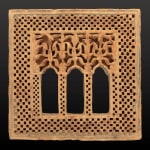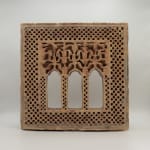Mughal Jali Architectural Ventilation Window Panel, 1600 - 1800 CE
Red sandstone
height 33 cm
height 13 in
height 13 in
LI.3309
Further images
-
(View a larger image of thumbnail 1
)

-
(View a larger image of thumbnail 2
)

-
(View a larger image of thumbnail 3
)

-
(View a larger image of thumbnail 4
)

-
(View a larger image of thumbnail 5
)

-
(View a larger image of thumbnail 6
)

-
(View a larger image of thumbnail 7
)

-
(View a larger image of thumbnail 8
)

-
(View a larger image of thumbnail 9
)

-
(View a larger image of thumbnail 10
)

-
(View a larger image of thumbnail 11
)

This delicately ornate Mughal ventilation panel is a stunning example of iconic Mughal architecture rendered in red sandstone. The panel features three small arched windows, in the Indo-Islamic style. Above...
This delicately ornate Mughal ventilation panel is a stunning example of iconic Mughal architecture rendered in red sandstone. The panel features three small arched windows, in the Indo-Islamic style. Above the windows are ornate floral patterns. Framing the windows are geometric, checkerboard patterned ventilation holes–a key feature of Indo-Islamic architecture called jali. Jali, meaning “net” is a latticed or perforated stone screen, usually featuring geometric, quranic, or floral patterns. These ventilation screens are designed to allow light in and provide cooling through passive ventilation. Mughal architecture is renowned for its intricate detailing, inlaid ornamentation, and extensive use of white marble and red sandstone. Its style combines Hindu, Persian, and Islamic influences–most notably observed in the Mughal ruler Shah Jahan’s Taj Mahal.
The Mughal Empire was one of the most powerful and influential empires within the South Asian subcontinent, stretching from the edge of the Indus river basin to Bangladesh in the East. The Islamic empire reigned from the 16th to the 19th century, led by notable rulers such as Akbar, Aurangzeb, and Shah Jahan. The Mughals contributed greatly to regional architectural styles of South Asia, establishing national monuments in present day India, Pakistan, Bangladesh, and Afghanistan.
The Mughal Empire was one of the most powerful and influential empires within the South Asian subcontinent, stretching from the edge of the Indus river basin to Bangladesh in the East. The Islamic empire reigned from the 16th to the 19th century, led by notable rulers such as Akbar, Aurangzeb, and Shah Jahan. The Mughals contributed greatly to regional architectural styles of South Asia, establishing national monuments in present day India, Pakistan, Bangladesh, and Afghanistan.










